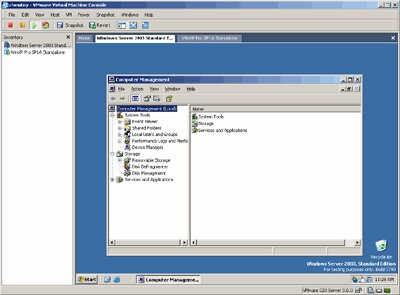|
From CertCities.com
|
||
|
Column Microsoft: Under the Hood Imaginary Servers Don Jones on using products like Microsoft Virtual Server and GSX Server to take your network beyond the physical. by Don Jones 8/4/2004 -- Unless you've been hiding under a rock, you're familiar with Microsoft's buyout earlier this year of Connectix Virtual PC, and EMC's acquisition of VMWare, Inc. Many of you are probably familiar with Virtual PC and VMWare Workstation; both are great virtual computing tools that let you run multiple "guest" operating systems inside a window that essentially represents a complete, imaginary computer. Both VMWare and Virtual PC perform a level of hardware emulation, so that the operating system running inside the window thinks that it's running on a standalone, dedicated piece of hardware. But Microsoft and EMC didn't spend big bucks acquiring technologies that are more or less limited to developers, testers, trainers, and hobbyists. They're perfectly happy selling these "imaginary workstation" products, but the big bucks are in selling imaginary servers. The Year of the Virtual Computer It's getting hard to find parts for these old servers, and you're sick to death of babysitting them. Easy enough to imagine. Virtual computing would let you consolidate them without, it seems, consolidating them. In other words, you go buy one big box. It runs six virtual servers, each of which contains an NT 4.0 server representing one of your original six old servers. The actual physical NT servers are in the trash. Boom, instant consolidation, but your six original servers still "exist," sort of, so you don't have to change any of your clients (slot machines). Lots of Choice GSX Server is really cool. If you've seen VMWare Workstation 4.5, then GSX Server's UI, shown below will look really familiar. You get a list of servers in the left-hand pane, and a tabbed interface that displays the virtual computers' desktops. Each tab represents one running virtual computer. The cool part of GSX is that the virtual computer is actually executing on a remote machine; only the UI is actually being displayed on your client computer. You can think of it as a kind of Remote Desktop capability, I suppose, only you're looking right at the server's console, not a virtual desktop. Plus, you can still RDP into these virtual servers, since they're just Windows servers and have all the features that Windows has (GSX can host more than just Windows, of course; Linux and any other x86-based operating system is fair game).
Under the Hood Other hardware is usually emulated in the same halfway method. In fact, for the most part, hardware operations are executed by the actual physical hardware, with the virtual computing software acting only as an arbiter to help prevent resource contention. Some hardware operations — notably the motherboard BIOS — are entirely emulated, using real BIOS binary code licensed from real BIOS manufacturers like Award and Phoenix. Things do get tricky with video. The virtual machine believes it has the entire display area to work with; that might not be the case. When I run a virtual machine in 800x600 mode, and display it on a 1024x768 monitor, the virtual machine is only getting a fraction of the display space. So both VMWare and Microsoft emulate the video hardware and provide custom SVGA drivers, allowing them to intercept the video calls and map them onto the physical display in the appropriate location. This doesn't really impact performance much unless you're trying to play Halo or something inside the virtual machine; I've not been able to get that running really well, but for most other applications video isn't a problem. Tools and Utilities Other tools include imaging and migration tools that allow you to suck a physical server into a virtual server. VMWare has a P2V Assistant, and Virtual Server will ship with a similar migration tool. The idea behind these tools is to quickly migrate a physical server into a virtual one for consolidation purposes, providing minimal downtime for end users and minimal effort for yourself. Because VMWare Workstation and VMWare GSX Server use essentially the same virtualization software, you can easily move virtual machines between the two. Imagine being able to "copy a server" from a GSX host onto your laptop, and then run it inside VMWare Workstation for testing and experimentation purposes! You can modify the networking layer of the virtual machine so that the copy on your laptop uses "local only" networking, thus preventing it from being seen on your network and having a server naming conflict with the copy running under GSX. This is an incredibly cool way to test new applications and stuff using an actual copy of a production server, without touching the production server itself. I'm not certain if Virtual PC/Server will have this interchangeability; Virtual Server is implementing stuff like virtual SCSI disks which the current version of Virtual PC doesn't support. It's possible, though, that some future version of Virtual PC will incorporate the new stuff in Virtual Server and bring the two to a similar level of functionality. Go Get Virtual Don Jones is the owner and operator of ScriptingAnswers.com, a speaker at national technical IT conferences, and the author of nearly twenty books on information technology. His latest book is "Managing Windows with VBScript and WMI" (Addison-Welsey) and he's completing "Windows Administrator's Automation Toolkit" (Microsoft Press). You can reach Don at his Web site or at . |
||
|
top Copyright 2000-2009, 101communications LLC. See our Privacy Policy. For more information, e-mail . |
